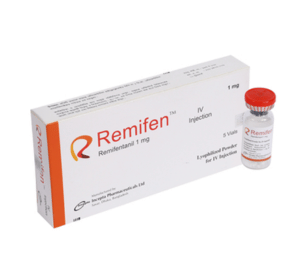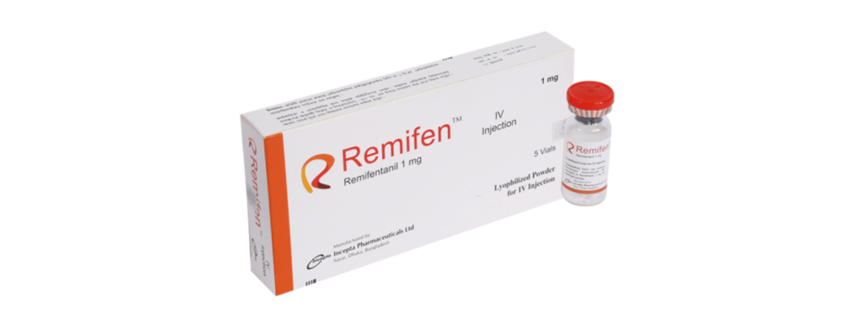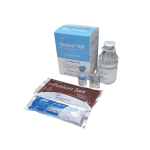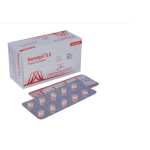Remifen(Remifentanil Hydrochloride)

Therapeutic Group: µ-opioid agonisTherapeutic Group: µ-opioid agonis
Presentation
Remifen Injection: Each vial contains Remifentanil Hydrochloride BP equivalent to Remifentanil 1 mg as lyophilized
powder.
Description
Remifentanil Hydrochloride is a µ-opioid agonist with rapid onset and peak effect and short duration of action. The
µ-opioid activity of Remifentanil Hydrochloride is antagonized by opioid antagonists such as naloxone. Its effects and
side effects are dose dependent and similar to other µ-opioids.
Indications
Remifentanil Hydrochloride is indicated for IV administration:
1. As an analgesic agent for use during the induction and maintenance of general anesthesia for inpatient and
outpatient procedures.
2. For continuation as an analgesic into the immediate postoperative period in adult patients under the direct
supervision of an anesthesia practitioner in a postoperative anesthesia care unit or intensive care setting.
3. As an analgesic component of monitored anesthesia care in adult patients.
Dosage & Administration
Remifentanil Hydrochloride is for IV use only. Continuous infusion of Remifentanil Hydrochloride should be
administered only by an infusion device. The injection site should be close to the venous cannula and all IV tubing
should be cleared at the time of discontinuation of infusion.
Side Effects
Remifentanil Hydrochloride produces adverse events that are characteristic of µ-opioids, such as respiratory
depression, bradycardia, hypotension, and skeletal muscle rigidity. These adverse events dissipate within minutes of
discontinuing or decreasing the infusion rate of Remifentanil Hydrochloride. Other adverse events are – nausea,
vomiting, shivering, fever, dizziness, visual disturbance, headache, respiratory depression, apnea, pruritus,
tachycardia, postoperative pain, hypertension, agitation. hypoxia, chills, flushing, warm sensation, constipation,
premature ventricular beats, myocardial ischemia, atrial fibrillation, decreased cardiac output, coagulation disorder,
arrhythmia, ventricular fibrillation, postoperative complication, third degree heart block, hemorrhage, perioperative
complication, involuntary movement(s), thrombocytopenia, oliguria, anemia, atrial fibrillation, confusion, ache,
anxiety, diarrhea, edema, atrial flutter, hallucinations, pneumonia, pharyngitis, decreased mental acuity, dyspnea,
cough, renal insufficiency, urine retention, cerebral infarction, premature ventricular beats, cerebral ischemia,
paresthesia, seizure, sleep disorder, bronchospasm.
Precautions
Remifentanil Hydrochloride is not recommended as the sole agent in general anesthesia because loss of
consciousness cannot be assured and because of a high incidence of apnea, muscle rigidity and tachycardia.
Remifentanil Hydrochloride should only be administered by clinicians specifically trained to use intravenous
anesthetics. It is essential that qualified personnel and adequate facilities are available for the treatment of
postoperative respiratory depression. Respiratory depression will abate approximately 10 minutes after the
discontinuation of a Remifentanil Hydrochloride infusion. Administration of the narcotic antagonist, naloxone, has not
been shown to be more effective or more prompt in reversing respiratory depression than the discontinuation of
Remifentanil Hydrochloride. Naloxone can be used to manage severe respiratory depression or muscle rigidity. Bolus
doses of Remifentanil Hydrochloride should not be administered to patients who are spontaneously breathing and
also receiving a continuous infusion of Remifentanil Hydrochloride.
Administration of Remifentanil Hydrochloride at a rate greater than 0.2 mcg/kg/min is usually associated with
hypoventilation (respiratory rate of less than 8 breaths/minute). The manufacturer strongly recommends that
supplemental oxygen be supplied whenever Remifentanil Hydrochloride is administered.
Analgesic effects will dissipate within 5 to 10 minutes after discontinuation of Remifentanil Hydrochloride. Adequate
postoperative analgesia should be established prior to discontinuation of Remifentanil Hydrochloride.
The intravenous tubing supplying the Remifentanil Hydrochloride infusion should be cleared of residual drug after the
discontinuation of therapy.
Vital signs and oxygenation must be continually monitored during the administration of Remifentanil Hydrochloride.
Bradycardia has been reported with Remifentanil Hydrochloride. Hypotension has been reported with Remifentanil
Hydrochloride.
Use in Pregnancy & Lactation
Pregnancy Category C. It is not known whether Remifentanil Hydrochloride is excreted in human milk. Because
fentanyl analogs are excreted in human milk, caution should be exercised when Remifentanil Hydrochloride is
administered to a nursing woman.
Over Dose
Expected signs and symptoms of overdoses include: apnea, chest-wall rigidity, seizures, hypoxemia, hypotension,
and bradycardia.
Storage
Do not store above 30ºC. Keep away from light and out of the reach of children.
Commercial Pack
Remifen Injection: Each box contains 5 vials of 1 mg Remifentanil lyophilized powder.



